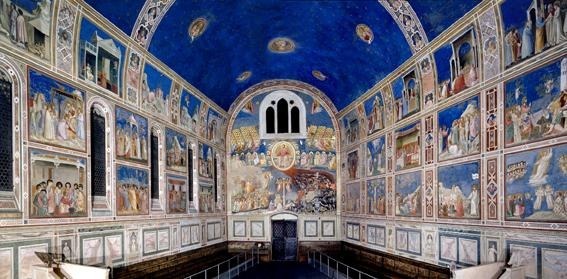| Geometry of Greek vases with geometric proportions of the golden ratio. (http://en.citizendium.org/wiki/Golden_ratio) |
From using shapes, which are two dimensional, to develop the golden ratio, which is applied to three-dimensional objects. The inverse was performed as well, such that three-dimensional objects, scenes, and people were painted on a two-dimensional canvas. Paintings by Giotto di Bondone and Leonardo da Vinci were examples of depth on a canvas (D'Arcais). The idea of depth on a canvas is portrayed by the artists and the final product is art. What I noticed was that the process of developing the sense of depth is also called sfumato and requires lots of math such measuring distance of edges and points, transformation, and use of angles (Hulsey & Trusty). Additionally, it seems that artists in the Renaissance era worked together with other intellectuals such as mathematicians to create art. This collaboration seems to be a bridge between the two cultures and makes me wonder if it still occurs in our capitalistic society.
 |
|
Scrovegni Chapel Frescoes (1303-10) by Giotto, the greatest artist of the trecento, who paved the way for the Italian
Renaissance of the 15th century. |
 |
|
Nativity by Giotto, from the Scrovegni Chapel
|
 |
| Taiwan Goldfish, Opus 716 by Robert J. Lang |
The final example of art crossing paths with math is the art of origami, transforming a two-dimensional canvas to a three-dimensional object. The activity that pops right in my head is folding the perfect paper airplane that flies the furthest relative to my friends' paper airplanes! Looking back now, I realize that to create the perfect paper airplane, I had to focus on the symmetry of the folds, wide airplane wings for better lift, linear airplane body; all of which can be seen as mathematics and physics! In a similar manner, the origami art by Robert J. Lang is rather precise, as he notes important measurements for every piece of his art (Lang).
 |
|
Ink/water imprinted crease
pattern
cause self-folding (April, 2012)
by Industrial Design student,
Christophe Guberan,
from Ecole Cantonale d’art de Lausanne.
|
 |
|
Foldable Paper Lithium-Ion Battery, by researchers from
Arizona State University.
|
Sources:
1. D'Arcais, Francesca Flores. “Giotto Di Bondone.” Art in Tuscany, www.travelingintuscany.com/art/giotto.htm.
2. Hulsey, John, and Ann Trusty. “What's Sfumato with You?” Artists Network, 14 Dec. 2017, www.artistsnetwork.com/art-mediums/oil-painting/whats-sfumato-with-you/.
3. Lang, Robert J. “Robert J. Lang Origami.” Robert J. Lang Origami, www.langorigami.com/.
4. “Origami Science.” Origami-like Techniques Used in Advanced Tecnologies.,
www.origami-resource-center.com/origami-science.html.
5. uconlineprogram. "Mathematics-pt1-ZeroPerspectiveGoldenMean.mov." Online video clip. YouTube. YouTube, 9 April 2012. Web. 13 April 2017.
Comments
Post a Comment